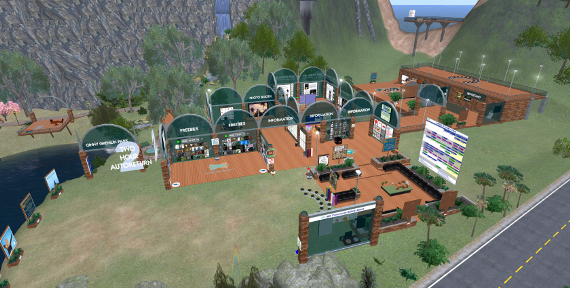It has been in Second Life for four years (having just celebrated its fourth anniversary), has over 150 staff, costs about US$13,000 each year to operate, holds 46,592 square metres of Second Life land (and rents quite a bit more), and is among the virtual environment’s most well-trafficked organizations.
It isn’t one of those corporate sites you read about, though. It’s a non-profit group, with little existence outside of Second Life. It’s NCI, a volunteer organisation that ranks among the most successful groups in Linden Lab’s virtual world.
NCI’s basic mission is to assist and support newcomers to Second Life. Originally founded by Brace Coral in April 2005, Coral named the organisation New Citizens Incorporated (though the ‘incorporated’ part was merely in jest), and founded it on the principle that everyone in Second Life was able to contribute to the orientation and support of new users. Even those with only a few days of experience would have answers and information that newer users lacked.
Originally a self-help facility with social events and a building sandbox, the scope of NCI was already expanding by the time Carl Metropolitan took over as executive director in a popular vote in September 2005, when Brace Coral scaled back her Second Life activities.
With Metropolitan at the helm of the organization, NCI expanded significantly both in land and personnel, offering large numbers of classes and events, funded by advertising and donations, and standalone ‘aid stations’ called Infonodes scattered all over Second Life near areas where new users are likely to be found. NCI’s financial picture isn’t always a rosy one, however.
Advertising and donations don’t quite meet the operational bills each year, usually falling about US$1,500 short, which necessitates periodic fundraising activities to make up the shortfall, often in the form of charity auctions. NCI’s charity fundraisers are supported by quite a number of Second Life creators, as well as some corporations, such as Microsoft who donated software to the last big fundraising auction.
In an environment where users only have a limited number of group memberships available, NCI’s free-to-join group sports nearly 9000 members at present, and provides round-the-clock live-help for new users with questions and queries.
The NCI’s watch-words are civility, respect and courtesy, but maintaining a safe space for new users, protected from those who would exploit them or intentionally disrupt or harass them isn’t easy. NCI maintains strict rules of conduct, and enforces them swiftly when staff feel that new users may become upset or disturbed by the actions of a disruptive or abusive visitor. Indeed, one of the main pillars of NCI’s popularity is swift and strong enforcement of local conduct rules.
Keeping an organization like NCI running isn’t an easy job either. While class instructors and event hosts recieve payments from the organisation for their duties, nobody is getting a wage from the process. Senior staff can be under tremendous amounts of pressure. In the wake of NCI’s 4th anniversary celebration on 18 April, executive director, Carl Metropolitan decided that he needed a sabbatical, partly from the daily pressure of work, and partly due to unavoidable circumstances related to the USA’s economic downturn.
Presently, a new interim management team are settling in, with Afon Shepherd and Gramma Fiddlesticks cooperatively managing the organisation until Metropolitan’s return to duty. That NCI works at all is something of a surprise, being an expensive operation, with so many people from all walks of life, from most of the countries in the world, bonded primarily only by the willingness to help others and to donate their spare time.
NCI does work, however, and it works well. If you’re new to Second Life, it’s one of those must-visit places.

NCI Major Locations

 1. Need to create terrain on an OpenSim grid?
1. Need to create terrain on an OpenSim grid?  When I used to take the train home from school everyday, I would admire how the lighting outside would seep over the windows, until they were a golden hue and it was too bright to see through them. It was like all the people, ending their active work days, would be lost in a tunnel of celestial yellow skies. You couldn’t help but smile, no matter how bad your day was.
When I used to take the train home from school everyday, I would admire how the lighting outside would seep over the windows, until they were a golden hue and it was too bright to see through them. It was like all the people, ending their active work days, would be lost in a tunnel of celestial yellow skies. You couldn’t help but smile, no matter how bad your day was.
Recent Comments